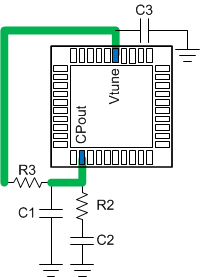SNAS680E December 2015 – August 2022 LMX2582
PRODUCTION DATA
- 1 Features
- 2 Applications
- 3 Description
- 4 Revision History
- 5 Pin Configuration and Functions
- 6 Specifications
- 7 Detailed Description
-
8 Application and Implementation
- 8.1
Application Information
- 8.1.1 Optimization of Spurs
- 8.1.2 Configuring the Input Signal Path
- 8.1.3 Input Pin Configuration
- 8.1.4 Using the OSCin Doubler
- 8.1.5 Using the Input Signal Path Components
- 8.1.6 Designing for Output Power
- 8.1.7 Current Consumption Management
- 8.1.8 Decreasing Lock Time
- 8.1.9 Modeling and Understanding PLL FOM and Flicker Noise
- 8.1.10 External Loop Filter
- 8.2 Typical Application
- 8.3 Power Supply Recommendations
- 8.4 Layout
- 8.1
Application Information
- 9 Device and Documentation Support
- 10Mechanical, Packaging, and Orderable Information
8.1.10 External Loop Filter
The LMX2582 requires an external loop
filter that is application-specific and can be configured by the PLLatinum™ simulation tool found here. For the LMX2582, it matters what impedance is seen from the
Vtune pin looking outwards. This impedance is dominated by the component C3 for a third
order filter or C1 for a second order filter. If there is at least 3.3 nF for the
capacitance that is shunt with this pin, the VCO phase noise will be close to the best
it can be. If there is less, the VCO phase noise in the 100-kHz to 1-MHz region will
degrade. This capacitor should be placed close to the Vtune pin.
 Figure 8-10 External Loop Filter
Figure 8-10 External Loop Filter
 Figure 8-10 External Loop Filter
Figure 8-10 External Loop Filter